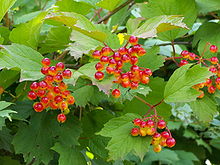- Viburnum opulus
-
Viburnum opulus Plant with fruit Scientific classification Kingdom: Plantae (unranked): Angiosperms (unranked): Eudicots (unranked): Asterids Order: Dipsacales Family: Adoxaceae Genus: Viburnum Species: V. opulus Binomial name Viburnum opulus
L.Viburnum opulus (Guelder Rose, Water Elder, European Cranberrybush, Cramp Bark, Snowball Tree) is a species of Viburnum, native to Europe and Asia. Some botanists also treat the closely related North American species Viburnum trilobum as a variety of it (as Viburnum opulus var. americanum Ait.), or a subspecies, Viburnum opulus subsp. trilobum (Marshall) Clausen. The common name 'Guelder Rose' appears to have originated because a popular cultivar, the Snowball tree supposedly first originated in the Dutch province of Gelderland.[1]
Contents
Growth
It is a deciduous shrub growing to 4-5 m tall. The leaves are opposite, three-lobed, 5-10 cm long and broad, with a rounded base and coarsely serrated margins; they are superficially similar to the leaves of some maples, most easily distinguished by their somewhat wrinkled surface with impressed leaf venation. The leaf buds are green, with valvate bud scales.
The hermaphrodite flowers are white, produced in corymbs 4-11 cm diameter at the top of the stems; each corymb comprises a ring of outer sterile flowers 1.5-2 cm diameter with conspicuous petals, surrounding a center of small (5 mm), fertile flowers; the flowers are produced in early summer, and pollinated by insects. The fruit is a globose bright red drupe 7-10 mm diameter, containing a single seed. The seeds are dispersed by birds.
Cultivation and uses
It is commonly grown as an ornamental plant for its flowers and berries, growing best on moist, moderately alkaline soils, though tolerating most soil types well. Several cultivars have been selected, including 'Roseum' (synonym 'Sterile', 'Snowball'), in which all the flowers are only of the larger sterile type, with globular flower heads. There is some confusion, as there are a few other bushes, including other members of the Viburnum genus, also referred to as "snowball bush".
The shrub is also cultivated as a component of hedgerows, cover plantings, and as part of other naturalistic plantings in its native regions.
It is naturalised in North America, where it has been misleadingly re-named as "European Cranberrybush" (it is not a cranberry).
The fruit is edible in small quantities, with a very acidic taste; it can be used to make jelly. It is however very mildly toxic, and may cause vomiting or diarrhea if eaten in large amounts (Plants for a Future).
The dried bark is used in a tincture, known as "Cramp Bark," to alleviate painful menstrual cramps.
This herb is often used for treating feminine problems like menstrual cramps, postpartum discomfort, preventing miscarriages and internal hemorrhages and is used as a uterine sedative also. Additionally, it has a reputation for lowering diastolic blood pressure because of a reputed action on smooth muscle, and is both a smooth and skeletal muscle relaxant and antispasmodic.
Cultural meaning
Viburnum opulus (Kalyna) is the National symbol of Ukraine[citation needed]. Mentions of the bush can be found throughout the Ukrainian folklore such as songs, picturesque art, Ukrainian embroidery, and others. Chervona Kalyna was the anthem of the Ukrainian Insurgent Army. Kalyna Country is an ecomuseum in Canada.
This bush's symbolical roots can be traced into the Slavic paganism of millennia ago. According to a legend Kalyna was associated with the birth of the Universe, the so-called Fire Trinity: the Sun, the Moon, and the Star.[2][3] Its berries symbolize blood and the undying trace of family roots. Kalyna is often depicted on the Ukrainian embroidery: towels and shirts. In Slavic paganism kalyna also represents the beauty of a young lady which rhymes well in the Ukrainian language: Ka-ly-na - Div-chy-na.[4][5][6] That consistency was reviewed by numerous Ukrainian folklorists such as Nikolay Kostomarov, Aleksandr Potebnia (founder of the Kharkiv Linguistic School).
References
- ^ The Reader's Digest Field Guide to the Trees and Shrubs of Britain p.143.
- ^ Lady of Prykarpattia (Ukrainian)
- ^ Ukrainian embroidery (Ukrainian)
- ^ Doctor Bozhko, Agrarian Sciences. Tress in culture by folk. (Ukrainian)
- ^ Doctor Kuzmenko, Philological Sciences. The symbolics of guilder rose in Ukrainian songs of the 20th century national liberating movements. (English)/(Ukrainian)
- ^ a kalyna ne verba-live(Natalka Karpa) (youtube)
- Blamey, M. & Grey-Wilson, C. (1989). Flora of Britain and Northern Europe. Hodder & Stoughton.
- Huxley, A., ed. (1992). New RHS Dictionary of Gardening. Macmillan.
- Flora Europaea: Viburnum opulus
- Plants for a Future: Viburnum opulus
Categories:- Garden plants
- Medicinal plants
- Viburnum
- Flora of Armenia
- Flora of Azerbaijan
- Flora of Georgia (country)
- Flora of Russia
- Flora of China
- Flora of Japan
- Flora of Denmark
- Flora of Ireland
- Flora of Norway
- Flora of the United Kingdom
- Flora of Germany
- Flora of Estonia
- Flora of Latvia
- Flora of Lithuania
- Flora of Italy
- Flora of Romania
- Flora of France
- Flora of Ukraine
- Flora of New Brunswick
- Flora of Nova Scotia
- Flora of Ontario
- Flora of Quebec
- Flora of Alberta
- Flora of British Columbia
- Flora of Manitoba
- Flora of Connecticut
- Flora of Indiana
- Flora of Maine
- Flora of Massachusetts
- Flora of Michigan
- Flora of New Hampshire
- Flora of New Jersey
- Flora of New York
- Flora of Ohio
- Flora of Pennsylvania
- Flora of Vermont
- Flora of West Virginia
- Flora of Illinois
- Flora of Iowa
- Flora of Minnesota
- Flora of Nebraska
- Flora of North Dakota
- Flora of South Dakota
- Flora of Wisconsin
- Flora of Idaho
- Flora of Washington (state)
- Flora of Wyoming
- Flora of Virginia
Wikimedia Foundation. 2010.


